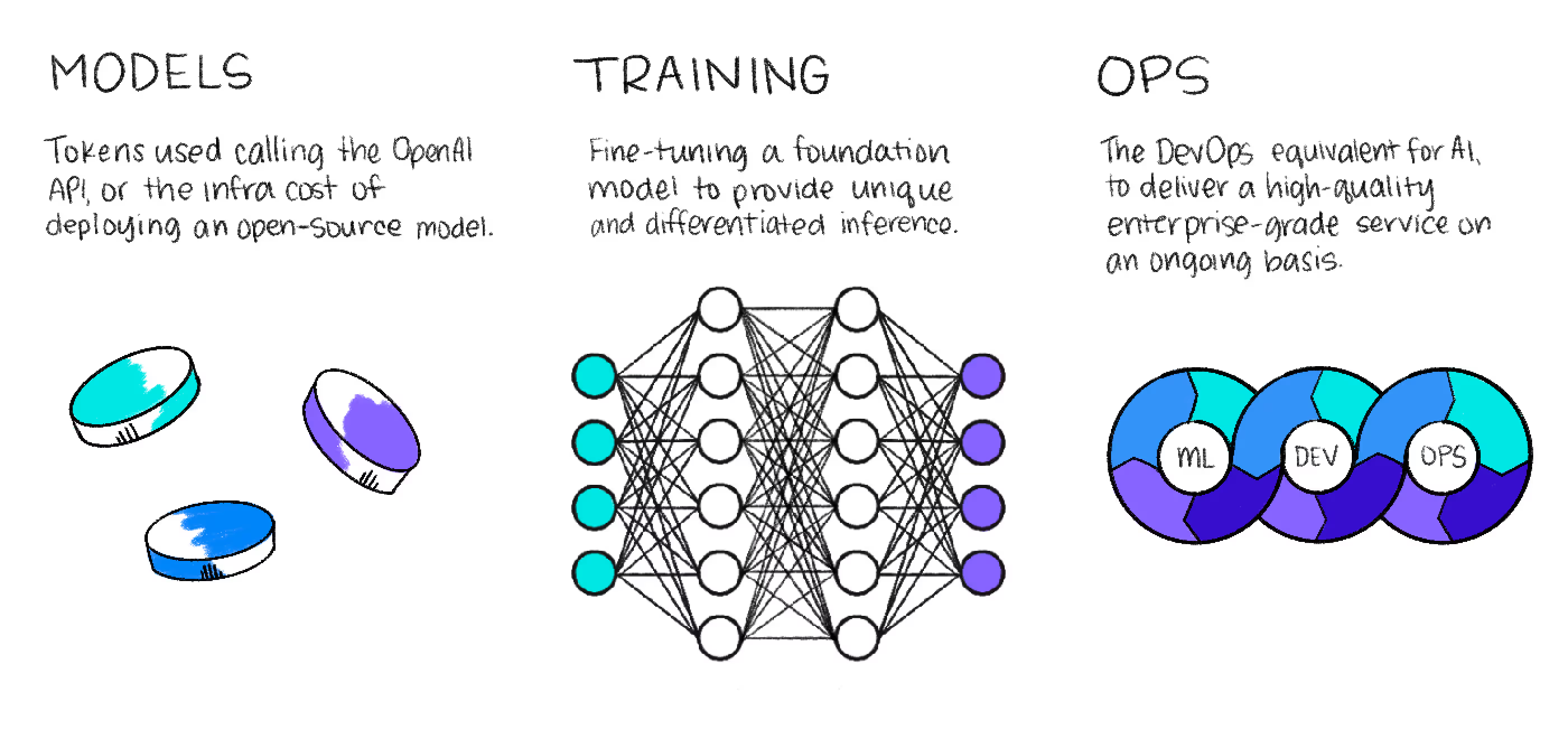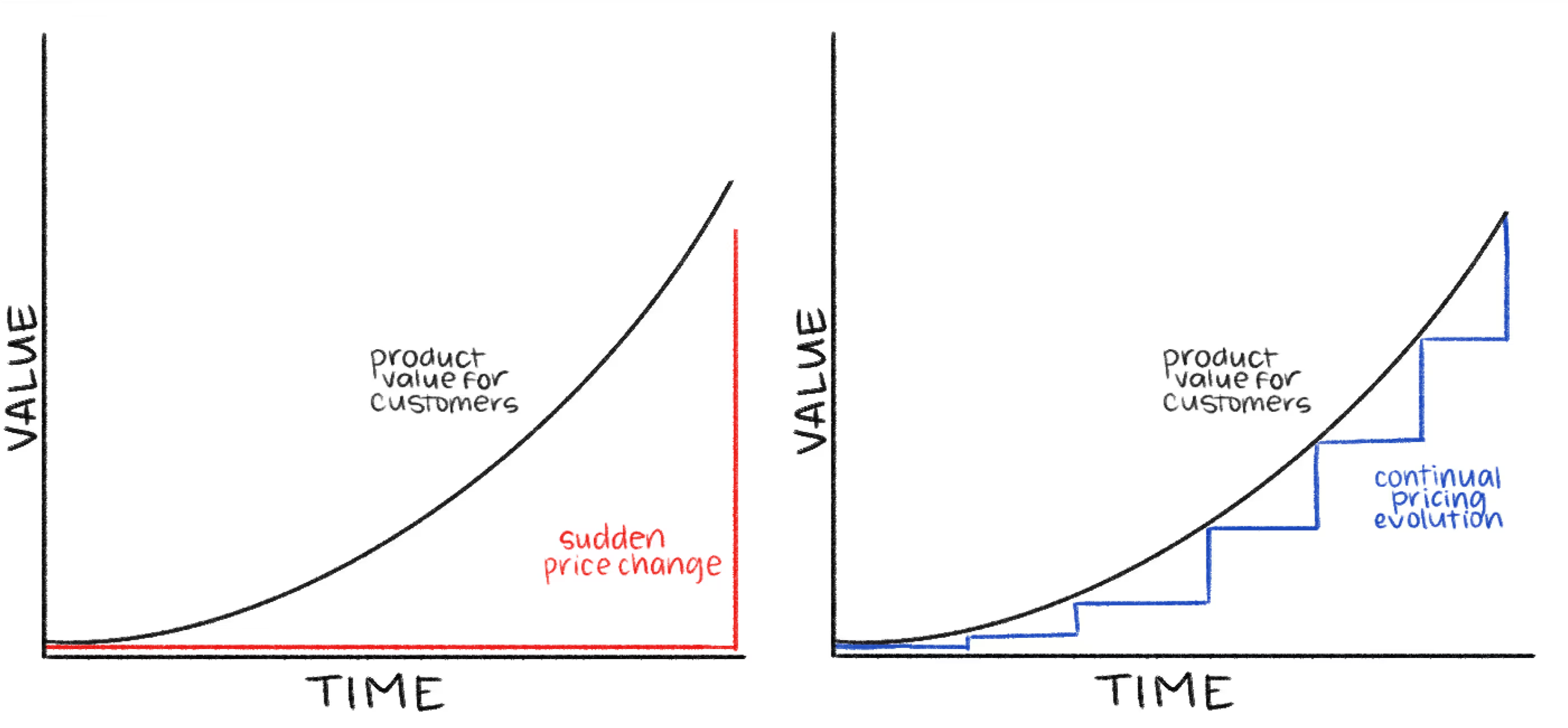We’re seeing it everywhere: AI integrated into our favorite tools at work, helping us better understand emails in just a few seconds, creating slide decks for our presentations, or taking notes during meetings so we can stay fully present. AI is a brave new world, and many are venturing into it quickly to leverage its power. And while advances in generative AI make products much more valuable, they also bring on some real costs. How should we think about AI pricing strategy?
Adding AI capabilities to fuel growth
At an increasingly rapid rate, companies are integrating AI in an effort to fuel their growth engines and drive accelerated adoption of their platforms. Doing so provides increased value to customers, contributes to a large amount of stickiness and internal virality, and builds massive data assets. These products’ growth flywheels will start spinning faster once they have more key inputs and content, as well as drive stickier workflows.
The economics of AI
On the backend, we must remember that these AI features and capabilities are associated with real costs and can impact your Cost of Goods Sold (COGS) and gross margins.
The cost structure of AI comes from several different factors, including the cost from the foundation models used to power AI capabilities. You might be charged for calls to the OpenAI API on a token basis or for the hosting cost of deploying an open-source model. There are also costs from fine-tuning and training models and from an ops layer, which is ultimately required to deliver an enterprise-grade, production-ready service over time.

As it stands, OpenAI's pricing is extremely granular and quite complex, charging small fractional units (e.g., $0.0015 per token). This simplifies the pricing down to a shared unit instead of establishing a different pricing scheme per AI model. But most companies integrating AI features have not yet moved to reflect this complex pricing model directly to their customers. Many have instead simplified to a flat add-on price in service of easier product adoption. If companies leave their pricing static as they add AI features, the more they will encroach on their margins. For example, if a company charges $10 monthly per seat and sees users start leveraging AI heavily, disproportionate cost structures could emerge—a shift in its COGS and, therefore, its gross margins.
How to think about AI pricing
Even though there's a lot of capability in terms of growth and new sticky workflows, it's imperative that companies adapt their pricing to reflect the value delivered by AI features. But in this wave of early adoption, we're not seeing companies steer toward complexity to the end user. Instead, they’re offering flat per-seat pricing, which doesn’t consider their changing cost structures. Which begs the question: why?
Ultimately, a great AI pricing strategy comes down to going back to first principles of a great pricing strategy:
- Decide what to optimize for
- Track costs, even if you aren’t directly charging for AI features (yet)
- Experiment with pricing and packaging, prioritizing simplicity
Develop an awareness of AI costs
The reason many companies are rolling out simplified pricing models on new AI feature sets is that we’re in a time of exploration and learning. These companies are still evaluating what differentiated value they can drive from such capabilities, how these new features impact their customer retention, churn, and lifetime value, and how to make these capabilities more durable and sticky. Often, the way to answer these questions is to get customers on board as quickly as possible. Of course, there will be a time when companies optimize for value capture and for margins—but now is not that time.
In this period, companies must be aware of their cost structures, including an understanding of their OpenAI bill and how their AI costs are distributed across different segments. It’s critical that companies know this even if they aren’t yet charging for AI capabilities.
Build a muscle of experimentation and learning
A key component of success in the new world of AI pricing is building a muscle of experimentation and learning. Companies must start by thinking about the necessary changes to their pricing models to get to a healthy margin and strategy and then start experimenting. Often, companies wait as long as possible to run pricing changes, resulting in a massive change management effort to raise their prices and catch up to the value they’re delivering.

Instead, pricing can and should be an iterative and ongoing exercise. When a company adds new AI capabilities and the value of its product is rapidly changing, it would benefit from experimenting with pricing changes.
The exciting part about pricing strategy is that, ultimately, it comes down to an exercise of trade-offs. Simply put, there is no silver bullet. Companies must figure out what to optimize for while knowing what they are trading off right now and in the future. Answering these questions comes down to judgment and knowing their customers.
Test out different AI pricing strategies
Testing AI pricing boils down to customer segmentation and understanding who gets the most value from AI capabilities—as well as how they perceive that value.
- Explore different packaging options to determine willingness to pay. Your product may already have tiers that map to different usage patterns in your customer base. Use qualitative user research and product analytics data to determine which segments are deriving the most value out of these new AI-powered capabilities and features.
- Select value metrics aligned with the value of your product. AI doesn’t just augment your product’s value, it might also introduce net-new ways your product can be valuable to customers. In some cases, it might be time to do away with seat-based pricing and rethink the fundamental unit of value. If your product value now correlates to AI-driven automation, consider moving to more of a usage-based or hybrid pricing strategy.
- Pick your battles and focus on the right segments. A self-serve offering can act as a great on-ramp for acquiring and expanding customers. Don't push very complex pricing schemes on that segment, as that may add too much friction to the buying process. When structuring enterprise agreements, consider leveraging different pricing structures that are more transparent about costs incurred—like token or pre-purchase models—as this can help negotiate long-term contracts.
Sure, AI is a brave new world, but AI pricing simply comes down to pricing fundamentals and thinking from first principles to arrive at what's best for your customers. In such a rapidly-evolving landscape, we must focus even more on revisiting pricing and experimenting with new tactics—or risk impacting our bottom lines. And while cost structures and gross margin profiles will be in flux, the key to achieving strong unit economics will always be to stay focused on the customer and the value we provide, and adopt a pricing framework accordingly.
At Orb, we're working with some of the most exciting companies tackling challenges in AI. To learn more about how Orb can support your usage-based billing model, you can try it out yourself of schedule a demo.



